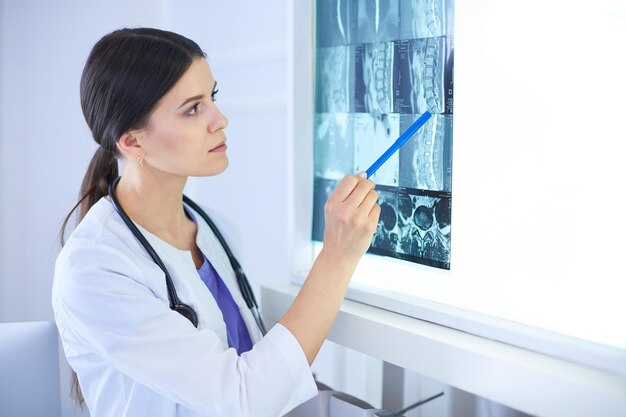Understanding T-Scores: What Constitutes a Bad T-Score for Osteoporosis?
Osteoporosis is a condition that weakens bones, increasing the risk of sudden and unexpected fractures. Often silent, it can make bones so brittle that a fall or even simple activities like bending or lifting can cause a bone to break. But how do we measure and classify the degree of osteoporosis? The answer lies in the T-score, a crucial metric for assessing bone density.
Decoding the T-Score: Your Bone Health Indicator
Your T-score is obtained from a bone density test known as a DEXA scan (Dual-energy X-ray Absorptiometry). This test measures the density of minerals (such as calcium) in your bones, providing a snapshot of your bone health.
What is a T-Score?
A T-score compares your bone density to that of a healthy 30-year-old of the same sex. Why 30-year-old? Because that's the age when bone density peaks. The results of your DEXA scan are expressed as a standard deviation—a statistical measure of variance—from this young normal reference.
- T-score of +1 to -1: Normal bone density
- T-score of -1 to -2.5: Osteopenia (low bone mass, a precursor to osteoporosis)
- T-score of -2.5 or lower: Osteoporosis
- T-score of -2.5 or lower with a fracture: Severe osteoporosis
When Is a T-Score Considered "Bad"?
A "bad" T-score can be subjective depending on the context, but generally:
- A T-score of -2.5 or lower confirms osteoporosis, indicating a higher risk of fractures.
- A T-score in the low -2s: Can signal an increased monitoring need and potential intervention.
However, even T-scores in the osteopenia range may warrant concern, as they increase the risk of developing full-blown osteoporosis over time.
Factors Influencing T-Scores
Several factors can impact your bone density and influence your T-score, including:
1. Age and Gender
Bone loss naturally accelerates with age, and women, particularly post-menopausal women, are at a higher risk due to lower estrogen levels, which are crucial for maintaining bone density.
2. Lifestyle Choices
- Diet: Inadequate calcium and vitamin D intake can weaken bones.
- Exercise: Lack of weight-bearing and resistance exercises can lead to poorer bone health.
- Smoking and Alcohol: Both can negatively impact bone health, leading to lower T-scores.
3. Genetic Factors
Family history can play a significant role in your susceptibility to osteoporosis.
4. Medical Conditions and Medications
Certain conditions (like rheumatoid arthritis) and medications (like corticosteroids) can hasten bone loss, impacting T-scores.
The Importance of Monitoring T-Scores
Regular monitoring of T-scores is vital for assessing bone health over time, especially for those with risk factors. Early detection via bone density tests enables proactive management of osteoporosis, potentially slowing its progression.
When To Get Tested
Your healthcare provider can guide when to start testing based on individual risk factors. Generally, the following guidelines apply:
- Women aged 65 and older and those post-menopausal under 65 with risk factors.
- Men aged 70 and older, and** younger men** with risk factors.
Managing Low T-Scores
While a low T-score might feel daunting, there are several steps you can take to manage and improve bone health.
Diet and Nutrition
- Calcium-rich foods: Dairy products, green leafy vegetables, and fortified foods are essential.
- Vitamin D: Sun exposure and foods like fatty fish or fortified cereals help with calcium absorption.
Exercise
Regular weight-bearing and strength-training exercises can help strengthen bones.
Lifestyle Modifications
- Quit smoking.
- Limit alcohol intake.
- Ensure adequate sun exposure for natural vitamin D synthesis.
Medical Interventions
For some, lifestyle changes may not be sufficient. Medications are available that can help increase bone density and reduce fracture risk, but they should only be considered after discussing with a healthcare provider.
Practical Considerations: Living with Osteoporosis
Beyond managing T-scores, living with osteoporosis requires everyday caution to minimize fracture risks.
Home Safety
- Remove tripping hazards like loose rugs.
- Ensure good lighting to prevent falls.
- Install grab bars in bathrooms and handrails on stairs.
Regular Check-ups
Consult with your healthcare provider regularly to monitor your condition and adjust your management plan as necessary.
Key Takeaways
Understanding and managing osteoporosis is all about vigilance and proactive care. A bad T-score mainly indicates the current state of bone health but also serves as a call to action for managing one's condition actively. Here are some key takeaways to consider:
- 📜 Know Your Score: Monitor your T-scores especially if you're in a high-risk group.
- 🥛 Prioritize Nutrition: Ensure adequate intake of calcium and vitamin D.
- 🏋️♀️ Stay Active: Engage in regular weight-bearing exercises.
- 🚫 Avoid Risky Habits: Limit smoking and alcohol consumption.
- 🛠 Keep Your Home Safe: Implement basic safety measures to prevent falls.
- 👨⚕️ Consult Regularly: Keep in touch with healthcare providers to adapt management plans.
Understanding what constitutes a "bad" T-score for osteoporosis heightens awareness and underscores the importance of comprehensive care, turning numbers on a scan into actionable steps towards stronger bones and better quality of life.

Related Articles
- a Nurse Is Caring For a Client Who Has Osteoporosis.
- a Percutaneous Is Performed To Treat Osteoporosis Related Compression Fractures
- Can Alcohol Cause Osteoporosis
- Can I Do Pilates If I Have Osteoporosis
- Can I Reverse Osteoporosis
- Can Men Get Osteoporosis
- Can Osteoporosis Affect Teeth
- Can Osteoporosis Be Cured
- Can Osteoporosis Be Painful
- Can Osteoporosis Be Reversed